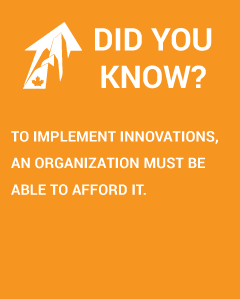

Innovation practice:
Project resources (e.g., capital, labour, plant, expertise and knowledge) are allocated to support innovation.
In order to innovate, an organization must invest. By innovation, we do not mean invention, but rather doing things better. Any changes to the usual way of doing things are usually associated with additional costs and the risk of failure, and naturally, an organization must be able to bear such costs and cope with the consequences in the case of failure. Therefore, it has long been recognized by Rosner (1968) and others, that planning resources for innovative activities is crucial for the successful implementation of innovations. Innovation will not magically happen on its own, but it will happen on purpose.
References:
- Damanpour, F. (1991). Organizational innovation: A meta-analysis of effects of determinants and moderators. Academy of Management Journal, 34(3), 555–590.
- Rosner, M. M. (1968). Economic determinants of organizational innovation. Administrative Science Quarterly, 614–625.
Next installment: You cannot improve what you do not measure
Previous installment: Rework is good, but only if it helps us measure and improve our quality

ABOUT THE PERFORMANCE BENCHMARKING TOOL
The free Performance Benchmarking Self-Assessment Tool is designed to assist construction and maintenance employers in measuring their organization in relation to a specific set of recognized best practices. In addition, you will be able to compare your organization’s efforts against other construction and maintenance employers. From the results of the self-assessment tool you will also be able to identify areas for continuous improvement.
The self-assessment tool is designed to be completed either individually by a member of your management team or in a collaborative setting. Consider bringing your leaders/managers together to work through the tool and take time to discuss the perspectives of each group member.
This initiative is supported by the National Research Council of Canada Industrial Research Assistance Program (NRC IRAP).

Productivity
